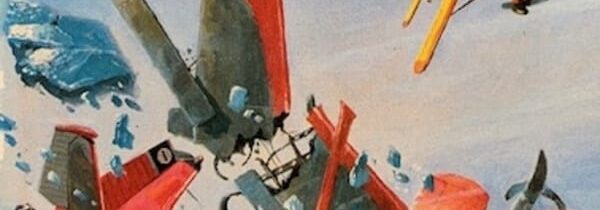THROWBACK THURSDAY: PATTERSON’S VOLUNTEERS by John Smith (Corgi, 1985)

Patterson’s Volunteers by John Smith (Corgi, 1984)
Patterson’s Volunteers by the little-known John Smith is a solid adventure yarn with a good deal of technical flying detail and a solid plot about a missing World War II squadron and a pile of gold.
John Smith only wrote two novels before reverting to the name of John Templeton Smith and venturing into action, spy novels. Born in England, Smith had the good fortune to live close to one of the masters of British thriller writing, Desmond Bagley. Bagley apparently mentored Smith, who was a pilot and aerospace journalist, and helped him to write his first novel under the Smith name, Sktytrap (1983). This was followed in quick succession by Patterson’s Volunteers (1984), before Smith headed to America and wrote a further 8 novels under the name of John Templeton Smith.
Patterson’s Volunteers is very much in the vein of novels by Gavin Lyall and Jack Higgins, with perhaps a nod towards Desmond Bagley himself. The story revolves around a squadron of sixteen P-51 Mustangs which went missing over the remote eastern section of Greenland at the tail end of the Second World War. When Luke Spence, a local Arctic ferry pilot and Vietnam War vet with a cloud hanging over him from an incident in the war, is approached to fly a small group to the suspected location of the planes he refuses. But entrepreneur Rollo Scarth is persistent and when Spence refuses the money that he is offering, Scarth blackmails the pilot into taking the job.
Reluctantly Spence finds himself flying an ageing de Havilland Beaver into an isolated section of Greenland in search of the planes and the cargo they were carrying. It is a dangerous task made more so by the horrendous weather conditions and the untrustworthy nature of his passengers.
It is quite an enjoyable adventure yarn. There is plenty of hazardous flying detail and Smith is good at making the reader feel the stress and tension of flying through a storm or landing on impossibly short ice landing strips. The technical detail is convincing, but there is probably too much of it, and Smith is good at conveying the beauty and harshness of the Arctic. The plotting is adequate, although Smith takes too long in setting his story up and there are too many extraneous strands. The ending is drawn out and probably lacks the excitement and surprises that a writer like Gavin Lyall would have brought to it. Nevertheless, it moves along at a reasonable pace and Spence is a solid action hero with a fair share of flaws and guilt from an incident during his tour in Vietnam.
Patterson’s Volunteers sits firmly in that vein of British adventure writing that developed and grew during the 1960s and 70s. The basic story could have easily been something concocted by Gavin Lyall or Hammond Innes, and it is actually a little reminiscent of Jack Higgins’ East of Desolation. The back cover of the book makes comparative references to Innes, Lyall and Dick Francis and the front cover has the look of the Fontana covers done for Geoffrey Jenkins’ books in the 1970s, although not as polished. At a quick glance it certainly looks like being in the same mold as Lyall and Jenkins. These writers, however, would have brought a bit more flair to it, if they had written it.
In all, I enjoyed it and will go back also re-read the first Smith book, Skytrap.


Jeff, Many thanks for posting this latter day review. Suffice to say it was down to the late, great Desmond Bagley, when we lived near to each other in Guernsey those many years ago, that I was persuaded to put pen to paper and through his mentoring spent half-a-happy-lifetime as a published author.
By the way you were close on the Gavin Lyall connection – in fact my Literary Agents, A.D. Peters at 10, Buckingham Street (just off the Strand), London were also Lyall’s. It so happened that Gavin told his agent he had had enough of writing ‘flying thrillers’ and was going to turn to something more cerebral – the Harry Maxim series if I remember correctly. The very next week, Desmond arranged for my manuscript ‘Skytrap’ to be mailed to A.D. Peters, who signed me up as Gavin Lyall’s replacement in the ‘flying thriller’ genre.
So you could say I landed on my feet, especially when publishers W.W. Norton, New York sent editor Tom Wallace to London to meet Gavin Lyall’s replacement and sign him up!
From that fortunate beginning I learned that ‘zero to hero needs 10% skill and 90% luck’.
In the Desmond Bagley tradition I am always available to give free advice to new writers.
John thanks for that. Fascinating information! I am planning on re-reading and reviewing Sky Trap in the next few weeks. Cheers Jeff
Jeff, I’m currently working on my memoirs amongst the other things one does in Act III. The prologue is a brief 12-pages (c. 7,500 words) outlining how I met Desmond Bagley and turned my hand to novel writing. It also covers how my first book- Skytrap – came into being.
If you would like me to send this over as an aide-memoire to your pending Skytrap review, please let me know. I can email to you as an attachment.
Best regards,
John
Hi. That would be great! I look forward to reading it. We are off to Cambodia and Vietnam for a few weeks on Friday, but i will get the review done when i get back. Cheers Jeff
Jeff, Hope you have a great trip to ‘Nam.
Check out ‘desmondbagley.co.uk’ and click on ‘People’. Then click on John Templeton Smith to go to the page – scrolling down you will find reference to ‘Tamanrasset Aitissal’.
This work-in-progress piece gives an outline how DB advised me on writing my first novel – Skytrap (set amidst African geography I was very familiar with in those days).
This Desmond Bagley site is run by old friend Nigel Alefounder in the UK, who keeps the DB legend alive. My privilege to have known the great man and my good fortune to have been mentored by him. Although it begs the question: “How did an ex-Air Force jock become a writer, when we all know they never graduate beyond the centre-fold of Playboy?” Even more kudos to DB and his re-education programme, I would suggest.
Best, JTS
Jeff,
If you can send me an email address I can forward the attachment I mentioned.
Best regards,
John
John Templeton Smith: I corresponded with you a long time ago about your novels. Have you written anything after Then A Soldier in 2002? When will your memoirs be published and how can we get hold of it?
Thank you.
Hi David, Nice to hear from you after all these years. If you contact me on my email address I will send you all the news.
Very best regards, John Templeton Smith
email: john.j.smith@btconnect.com
Hi John, I am reading SKYTRAP and was interested to see Zamboanga, Mindanao mentioned as I have lived in that City. I have also been to Manila. Kind regards, Mike
Mike
Hi. It’s Jeff here – its my blog.
John can be contacted on john.j.smith@btconnect.com
I am sure that he will be pleased that you are enjoying Skytrap. I wish he had done more books!
Cheers
Jeff
Thanks Jeff. I used John’s email but it came back as ‘blocked’. Any thoughts?
Cheers
Mike
It has been a few years since we last communicated. I will have a go and see what happens
Mike
I got the same response. In doing so I realised that I had last been in contact with John just before COVID. I did some digging around and found some updated info on the Desmond Bagley site which suggests that he was still writing in the early 2020s: https://desmondbagleyonline.wordpress.com/john-templeton-smith-2-2-2/